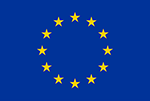This interactive map is specifically designed to facilitate the ground risk assessment of unmanned aircraft system (UAS) operations in accordance with SORA 2.5, and has been developed in collaboration with representatives of EU NAAs, UAS industry, EUROSTAT, EC JRC and EUSPA. This map encompasses the following data:
2.5, and has been developed in collaboration with representatives of EU NAAs, UAS industry, EUROSTAT, EC JRC and EUSPA. This map encompasses the following data:
The population density map is based on the 2021 census, (published by EC JRC in November 2024) and constitutes the most up to date EU-wide static population density data. The areas in the map with different shades of blue represent the Census population density values.
Since static population density data (i.e. census data) provide a representation where the population resides, it may be considered a reliable representation of population density when people are expected to be in their homes (e.g. during night). In other times of the day it may not provide the same level of reliability (e.g. people may be at work or in recreational areas like parks or beaches).
In order to mitigate such limitations, the information on residential population have been complemented with detailed land use or landcover information using the LUISA Base Map 2018 developed by EC JRC. The additional information given by the land use maps allows to identify the areas where data based on census are not suitable to represent population density, as the areas with high utilization in daytime or certain seasons. The areas in the map with different shades of violet represent the Census population density values.
Further background information and details on the static population density maps may be found in the guidelines available in this page.
View map in full screen
Note: The map is only suitable for display on desktop devices. A mobile version is currently in development. We apologize for any inconvenience.
This map is a module of the EASA Innovative Air Mobility (IAM) Hub which is a unique digital platform that brings together all actors in the European system including cities, regions, National authorities, the EU, operators and manufactures. The primary goal is to facilitate the safe, secure, efficient, and sustainable implementation of IAM practices. It is flagship action number 7 of the Drones Strategy 2.0.
 This project has received funding from a Contribution Agreement
This project has received funding from a Contribution Agreement
with the European Commission.
Any feedback?
Your feedback is welcome to this page and other IAM Hub deliverables.
